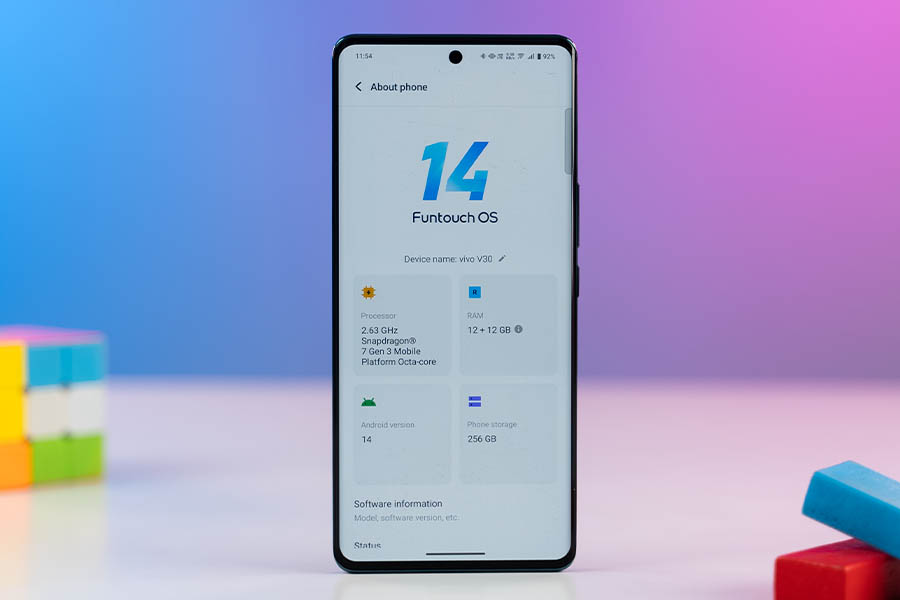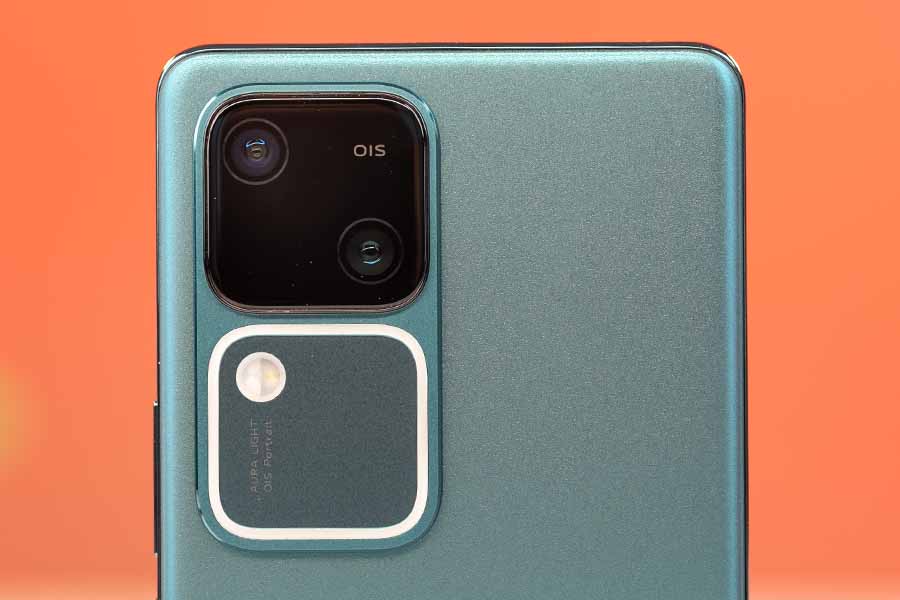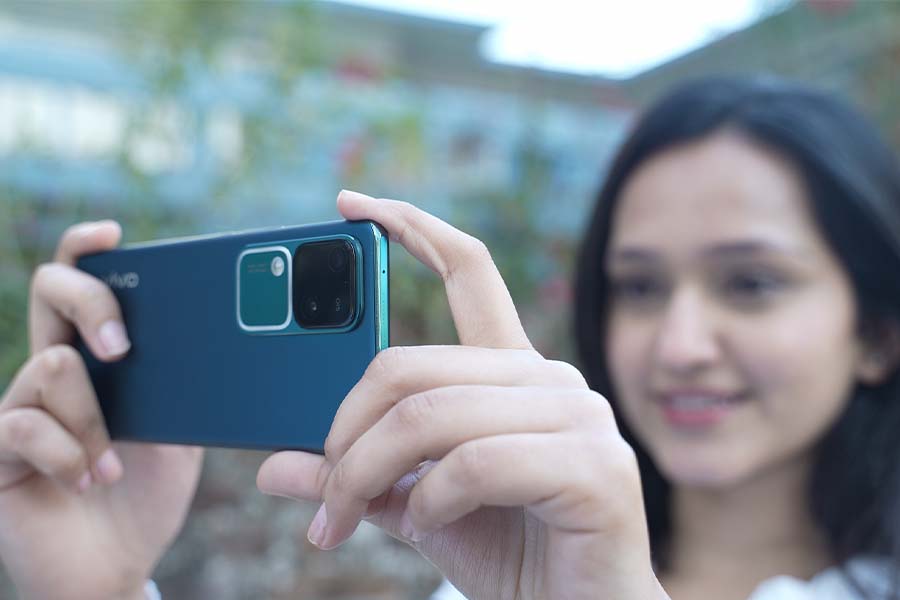
It’s 2024, and a new midrange phone from Vivo is here; the Vivo V30 5G. Acting as a successor to the V29, what’s new this time? It brings the new Snapdragon 7 Gen 3 chip, a 1.5K res AMOLED panel, a super slim design, and three 50MP cameras altogether. Seems like a definitive upgrade from the last-gen Vivo V29, right? Launched at the starting price of INR 30,000, is this phone good enough to compete in the already competitive 30K arena? Well, let’s find that out in my Vivo V30 5G review.
But before heading in, let’s have a look at its specifications.
Vivo V30 5G Specifications:
- Display: 6.78” AMOLED Panel, 2800 nits peak brightness
- Resolution: 2800 x 1260 pixels
- Chipset: Octa-core Qualcomm Snapdragon 7 Gen 3 (4nm)
- RAM: 12GB
- ROM: 256GB
- OS & UI: Android 14 with FunTouch OS 14 on top
- Rear Camera: Dual Camera (50MP OmniVision OV50E Primary + 50MP Ultrawide)
- Front Camera: 50MP Camera (Centre-aligned hole-punch cutout)
- Security: In-display fingerprint sensor, Face Unlock
- Battery: 5,000mAh with 80W super fast charging
- Color Options: Bloom White, Waving Aqua, Lush Green, Noble Black
- Price in Nepal: NPR 60,999 (12/256GB)
- Read the full specifications of the Vivo V30 5G here
Vivo V30 5G Review:
A gorgeous design
- Glass Front, Glass Back
- Color changing back
First and foremost, it’s a Vivo phone. So, I have to begin with the design side of things. The Vivo V30 continues to shine with a super sleek frame, measuring the same 7.8mm thinness as its predecessor the V29.

But things have changed– both on the front and rear side. You see, the camera module is new here, with two symmetrical squares– the upper one housing the dual camera setup while the lower one is booked for the regular flashlight and Vivo’s “Aura flashlight”.
Putting it side by side with the V29, I still feel the previous iteration looks a bit more polished and beautiful. But still, looks are subjective, so you might end up liking one or the other!

Anyway, the V30 does look premium in this color-changing Lush Green shade, I have. It shifts its color while being exposed to UV lights and it is fancy, I must say.
Besides this, you can get this phone in three more color options– Bloom White, Waxing Aqua, and Noble Black. And yes, there is also an IP54 rating against dust and water splash protection, but I feel a higher one would have made more sense here!
How’s the display?
- 6.78-inches AMOLED, 120Hz refresh rate, HDR 10+
- 2800 x 1260 pixels, 20:9 aspect ratio
Flipping to the front, the display is still curved but it’s now less curved than the V29, which to my liking is practical and less prone to accidental touches. So, despite the V29 boasting a premium outlook with its steep curves on the sides, I don’t really mind this change to the V30’s display.

Talking of the actual display quality itself, this 6.78-inch 120Hz AMOLED panel is sharp, thanks to its 1.5K resolution. With its fantastic and vibrant color outputs, minimal bezels, and HDR10+ certification, the display is quite a visual treat here. To compare, it looks a bit more punchier than the V29.
A single speaker again…
But you know what, Vivo has once again gone with a single speaker setup here (drumrolls please). It is loud and clear to listen but skipping a stereo speaker setup, time and again, oh come on Vivo!!!
Unoptimized refresh rate
Also, I don’t like how the smart switch settings cap the refresh rate to either 60 or 90Hz max on Chrome, Facebook, YouTube, and others. What’s the point of the panel supporting 120Hz, if you are going to limit it?
That being said, you can, however, set the refresh rate to 120Hz mode for that extra smoothness, until, the 90Hz mode kicks in midway again! While in some apps, it still goes up to 120Hz, which is sorta weird! So, it seems to be a software issue for now. Hope an update can fix this, maybe?
Battery Life and Haptics
- 5000mAh Battery
- 80W Fast charging
Despite not working properly, it’s worth going for this mode at least than the smart switch one, albeit, hitting a bit on the battery side. Talking of which, the V30 has an inbuilt 5000mAh battery, a 500mAh up from the V29. I got around 7 hours of SoT on the smart switch mode while the 120Hz mode provided me with around 6.5 hours. Which is decent!

You get an 80W fast charger bundled inside the box and it tops up the phone in about 48 minutes approx. One area where Vivo has still not addressed is the haptics. Yes, it’s still buzzy and it just doesn’t stand well in the competition, where you are getting a superior X-axis vibration motor.
Performance
- Octa-Core Snapdragon 7 Gen 3 5G (4nm mobile platform)
- Adreno 720
- 12GB RAM, 256GB Storage (fixed)
Okay, time to talk about the performance. Here, you get a Snapdragon 7 Gen 3 chipset, which is a 4nm fabbed SoC built on TSMC’s architecture. Making it the first global phone to get shipped with this new processor.

This midrange chip is more powerful than the last-gen Vivo V29’s Snapdragon 778G. Using it side by side will not show a lot of difference but the benchmark is where you can see the difference in both CPU and GPU aspects. Plus I also ran the 3D wildlife stress test, and the margin is double almost! Which makes it sound like a good chip for gaming.
However, the gaming performance remained similar on PUBG, CODM, and Mech Arena. But it’s on graphics-intensive games like Genshin Impact where the SD 7 Gen 3 outperforms the SD778G.
See, it scored an average of 54fps at medium + 60fps settings while the SD 778G could only score 40fps. Likewise, speaking of the thermals, I didn’t notice any heating issues on either of the phones.

All-in-all, this new chipset is a well-balanced one with no issues with multitasking and my other day-to-day chores like texting, scrolling social media, and so on.
Software
- Android 14 with Funtouch OS 14 on top
Software-wise, it boots on Android 14 out of the box with Funtouch OS 14 on top, which I’m not really fond of, as I have always said. The UI doesn’t miss any customization features and is fluid to use but, somehow, I feel like something is missing here. Samsung’s OneUI and Oneplus’s Oxygen OS have a better vibe, to my liking.

Also, Vivo is only promising two years of OS updates and one year more for the security patches, which is not that astounding as we are seeing 4+5 years of promise on Samsung and 3+4 years on other brands in 2024.
Optics
- Dual-camera setup at the back
- 50MP main (OIS), 50MP ultrawide
- 50MP selfie camera, AF
And let’s move to the camera section. This year as well, you are seeing a dual camera setup on the rear but the Ultrawide lens is now a 50MP one as opposed to the 8MP one on the V29. While the primary and front cameras remain the same at 50MP resolution.

Daylight
In daylighting conditions, the outputs from both of the siblings look nice with a good amount of detail and sharpness. I like how the V30 is leaning towards a more natural shade. On the contrary, the V29 captures punchier outputs with boosted colors. Well, you can choose either of them based on your color preference, but I have to give an edge to the V30 with a slightly better HDR here.
Ultrawide
Likewise, the higher-resolution UW on the V30 does make a difference. I found its outputs to retain better color accuracy and more details. It is much better than the reddish results from the V29’s 8MP ultrawide. Kudos to Vivo for this upgrade.
Selfies
Moving to the selfies, after all, it’s a Vivo phone, so you get pretty neat and eye-pleasing selfies. Compared to the V29, the skin tone is a bit brightened up but it looks good, good as it should be! Also, the autofocus does its job well with capturing sharp selfies with details.
Portraits
And what about portraits? Okay so, both the V30 and V29 offer you a 1X and 2X mode for capturing portrait shots.
As you can see, samples from both phones look good. To say, the V29’s outputs are a bit on the contrasty side while V30 is up for the brightened-up tones. And I would lean on the V30 here.
Lowlights
Now, let’s talk about the lowlight scenes. I can see Vivo has improved the night mode this time. The V30 now clicks good nighttime images without brightening up the entire scene, which is otherwise pretty visible on the V29.
Videos
And finally, getting to the videos, the V30’s rear camera can do 4K videos at 30fps. The EIS stabilization is not that great here. I can notice some jitters and wobbles, which Vivo needs to address soon. Turning on the ultra stabilization does help a bit but, the resolution gets dialed down to 1080p at 30fps.

Meanwhile, even the front camera is capable of shooting at 4K 30fps with a decent amount of detail and sharpness, but sadly, without any stabilization. So, using a gimbal can make it a good vlogging device.
Vivo V30 5G Reveiw: Conclusion
Okay wrapping things up, the Vivo V30 tries to stand out in the pack with a sleek design, and a good overall camera setup. The new SD 7 Gen 3 is a fairly powerful chipset that can handle your daily chores very well and can do some gaming as well.

The 50MP ultrawide camera has to be one of the best in the segment right now with natural color tones and good details. Also, the display is sharp with its 1.5K resolution and goes well for content watching. Even the battery life with a 5000mAh battery is commendable alongside the 80W fast charging.
But there are surely some negatives about this phone. The 120Hz refresh rate is not well optimized and gets jumped back to 90Hz even while turning on the 120Hz mode! And the single speaker setup at this price point is a bummer! Pair that with the buzzy haptics and a boring UI!
So, those fond of a sleek design, good cameras, and a chip good enough for some gaming, the Vivo V30 is a pretty standard option for y’all. But I wouldn’t term it as the best guy in the segment cause’ if you really love portraits, the upcoming Realme 12 Pro+ is the phone to beat with a dedicated 3X periscope lens.
Vivo V30 5G Review: Pros and Cons
Pros
- Elegant design
- Powerful performance
- Good cameras
- 80W charging
Cons
- Single speaker setup
- Buzzy haptics
- Average UI experience
- Poor Stabilization in videos



































































![Best Gaming Laptops in Nepal Under Rs. 250,000 (रु 2.5 Lakhs) [2025] Best Gaming Laptops Under 2.5 lakhs in Nepal [Feb 2025 Update]](https://cdn.gadgetbytenepal.com/wp-content/uploads/2025/02/Best-Gaming-Laptops-Under-2.5-lakhs-in-Nepal-Feb-2025-Update.jpg)
![Best Gaming Laptops in Nepal Under Rs. 120,000 (रु 1.2 Lakhs) [2025] Best Budget Gaming Laptops Under Rs 120000 in Nepal 2025 Update](https://cdn.gadgetbytenepal.com/wp-content/uploads/2025/05/Best-Budget-Gaming-Laptops-Under-Rs-120000-in-Nepal-2024-Update.jpg)
![Best Laptops Under Rs. 80,000 in Nepal [2025] Best Laptops Under 80,000 in Nepal March 2025 Update](https://cdn.gadgetbytenepal.com/wp-content/uploads/2025/03/Best-Laptops-Under-80000-in-Nepal-March-2025-Update.jpg)
![Best Gaming Laptops in Nepal Under Rs. 200,000 (रु 2 Lakhs) [2025] Best gaming lapotp under 2 lakhs Nepal Feb 2025](https://cdn.gadgetbytenepal.com/wp-content/uploads/2025/01/Best-Gaming-Laptops-Under-2-Lakh-Nepal-Feb-2025-Update.jpg)

![Best Mobile Phones Under Rs. 15,000 in Nepal [Updated 2025] Best Phones Under 15000 in Nepal 2024 Budget Smartphones Cheap Affordable](https://cdn.gadgetbytenepal.com/wp-content/uploads/2024/03/Best-Phones-Under-15000-in-Nepal-2024.jpg)
![Best Mobile Phones Under Rs. 20,000 in Nepal [Updated] Best Mobile Phones Under NPR 20000 in Nepal 2023 Updated Samsung Xiaomi Redmi POCO Realme Narzo Benco](https://cdn.gadgetbytenepal.com/wp-content/uploads/2024/01/Best-Phones-Under-20000-in-Nepal-2024.jpg)
![Best Mobile Phones Under Rs. 30,000 in Nepal [Updated 2025] Best Phones Under 30000 in Nepal](https://cdn.gadgetbytenepal.com/wp-content/uploads/2025/01/Best-Phones-Under-30000-in-Nepal.jpg)
![Best Mobile Phones Under Rs. 40,000 in Nepal [Updated 2025] Best Phones Under 40000 in Nepal 2024 Smartphones Mobile Midrange](https://cdn.gadgetbytenepal.com/wp-content/uploads/2024/02/Best-Phones-Under-40000-in-Nepal-2024.jpg)
![Best Mobile Phones Under Rs. 50,000 in Nepal [Updated 2025] Best Phones Under 50000 in Nepal](https://cdn.gadgetbytenepal.com/wp-content/uploads/2025/01/Best-Phones-Under-50000-in-Nepal.jpg)
![Best Flagship Smartphones To Buy In Nepal [Updated] Best flagship phone 2025](https://cdn.gadgetbytenepal.com/wp-content/uploads/2024/07/Best-Flagship-Phones-who-is-it-ft-1.jpg)